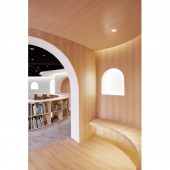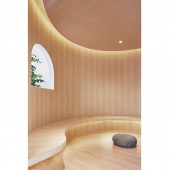Sissis Wonderland Reading Space by Leo Sun |
Home > Winners > #94465 |
 |
|
||||
| DESIGN DETAILS | |||||
| DESIGN NAME: Sissis Wonderland PRIMARY FUNCTION: Reading Space INSPIRATION: The configuration of spaces follows an idea inspired by the game of blowing bubbles: several spaces are arranged according to their scales and functions before recombined and attached like bubbles. Since spaces with different functions communicate and fusion with each other, a multitude of spatial forms and hierarchies are created, in which openness and independence, public and private, interior and exterior are overlapped and interconnected in a creative and pleasant way. UNIQUE PROPERTIES / PROJECT DESCRIPTION: After careful researches on various existing cases, designers found that the traditional way of children space design, with its flamboyant decoration, superficial embellishment and excessive use of meaningless figures, has lost its attractiveness. Hence they choose to make the project different by concentrate on the shape of the space itself, it's an attempt to turn the space itself into a giant toy, in which children can freely explore, discover and create their own lively experience. OPERATION / FLOW / INTERACTION: According to many researches, children of three to seven years old are in their most sensitive period of growing from their subjective worlds to the objective world. A flowing space like this helps expanding their perceiving and communicating abilities and reveal the true and creative nature in a child. PROJECT DURATION AND LOCATION: The project started in September 2018 in Shanghai and finished in November 2018 in Shanghai. FITS BEST INTO CATEGORY: Interior Space and Exhibition Design |
PRODUCTION / REALIZATION TECHNOLOGY: In order to elicit an amicable relationship between the space created and the surrounding plants, as well as to bring children closer to the nature, designers use wood as the main building material. The selection of white paint and the soft grey floor glue further guarantees the children a safe and interesting place to play, learn and interact. They grow green plants on the boundaries where different spaces meet, which helps sustaining the dynamic among person, space and nature. SPECIFICATIONS / TECHNICAL PROPERTIES: The project covers a total of 108 square meters. Thinking from the perspective of a child, designers planned and divided the space in children's scales. Though spatially limited by the floor area, they managed to squeeze in stairs with different heights, bookshelves that also serves as chairs, zigzagging ramps and mini arches in children's size. All of these are in children's scale. Boys and girls can climb up and down or play hide-and-seek in these facilities without parents worrying about potential dangers and injuries. TAGS: Interior, Parent-child Reading Space, Modern, Simple, Art, Interesting, Bubbles, Muxin Studio, Nature RESEARCH ABSTRACT: The varieties of spatial typology provide children with experiential guidance to explore boundaries between public and private spaces. During the process of moving through spaces with various qualities, the Introvert and extrovert tendencies of children are well reflected in their behaviors. In the experimental children reading space project, designers are aiming to create a cozy and amicable places for children to read and play, a place that inspires their imagination and creativity. CHALLENGE: The main topic of the project is to give different configurations according to different realms in spaces. Since spaces with different functions communicate and fusion with each other, a multitude of spatial forms and hierarchies are created. ADDED DATE: 2019-11-21 07:10:54 TEAM MEMBERS (5) : Yves Zhang, Leo Sun, Yiye Zhang, Dawei Jiang and Shuhang Zhang IMAGE CREDITS: Image #1: Photographer Daqi Zhang, Bookshelves, 2018. Image #2: Photographer Daqi Zhang, Mini Arches, 2018. Image #3: Photographer Daqi Zhang, Reading Space, 2018. Image #4: Photographer Daqi Zhang, Reading Space 2, 2018. Image #5: Photographer Daqi Zhang, Corridor, 2018. PATENTS/COPYRIGHTS: Copyrights belong to Leo Sun, 2018. |
||||
| Visit the following page to learn more: http://www.muxinstudio.com | |||||
| AWARD DETAILS | |
 |
Sissis Wonderland Reading Space by Leo Sun is Winner in Interior Space and Exhibition Design Category, 2019 - 2020.· Press Members: Login or Register to request an exclusive interview with Leo Sun. · Click here to register inorder to view the profile and other works by Leo Sun. |
| SOCIAL |
| + Add to Likes / Favorites | Send to My Email | Comment | Testimonials | View Press-Release | Press Kit |







